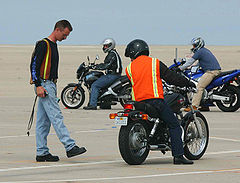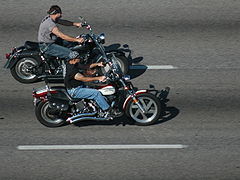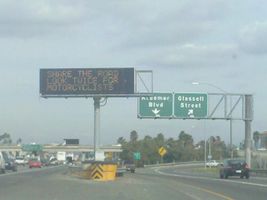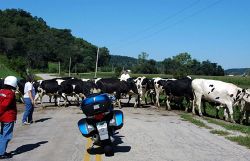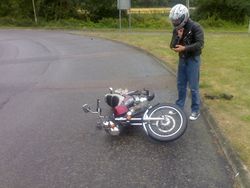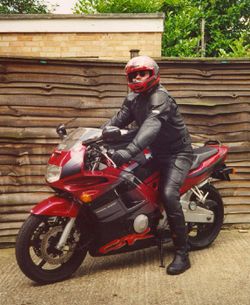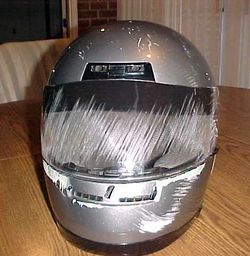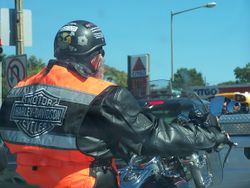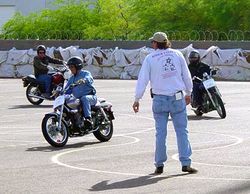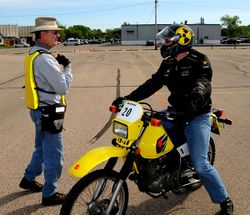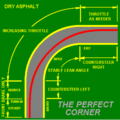Difference between revisions of "Motorcycle safety"
m (→Airbag devices) |
m (no summary specified) |
||
| (12 intermediate revisions by 4 users not shown) | |||
| Line 13: | Line 13: | ||
* Motorcycle riders aged 40 years and over are around 20 times more likely to be killed than other drivers of that same age.<ref>{{cite web|url=http://www.transport.sa.gov.au/rss/content/safer_people/road_users/motorcyclists_crashes.htm|publisher=Australian Transport Safety Bureau (ATS)|title=Motorcyclists - Crashes|date=}}</ref> | * Motorcycle riders aged 40 years and over are around 20 times more likely to be killed than other drivers of that same age.<ref>{{cite web|url=http://www.transport.sa.gov.au/rss/content/safer_people/road_users/motorcyclists_crashes.htm|publisher=Australian Transport Safety Bureau (ATS)|title=Motorcyclists - Crashes|date=}}</ref> | ||
According to 2005 data from the National Highway Traffic Safety Administration NHTSA, 4,008 motorcycle occupants were killed on United States roads in 2004, an 8% increase from 2003.<ref>{{cite web|url=http://www. | According to 2005 data from the National Highway Traffic Safety Administration NHTSA, 4,008 motorcycle occupants were killed on United States roads in 2004, an 8% increase from 2003.<ref>{{cite web|url=http://www.withviclegal.com/articles/motorcycle-helmet-fact-sheet|title=Motorcycle Helmets Fact Sheet|publisher=Highway and Auto Safety|accessdate=2007-06-26}}</ref> | ||
During that same period, drivers of automobiles showed a 10% increase in fatalities, and cyclists showed an 8% increase in fatalities. Pedestrians also showed a 10% increase in fatalities. A total of 37,304 automobile occupants were killed on U.S. roads in 2004.<ref>United States Department of Transportation, Fatality Analysis Reporting System Encyclopedia 1994-2005 [http://www-fars.nhtsa.dot.gov/Main/index.aspx]</ref> | During that same period, drivers of automobiles showed a 10% increase in fatalities, and cyclists showed an 8% increase in fatalities. Pedestrians also showed a 10% increase in fatalities. A total of 37,304 automobile occupants were killed on U.S. roads in 2004.<ref>United States Department of Transportation, Fatality Analysis Reporting System Encyclopedia 1994-2005 [http://www-fars.nhtsa.dot.gov/Main/index.aspx]</ref> | ||
| Line 24: | Line 24: | ||
===Hurt Report=== | ===Hurt Report=== | ||
{{main|Hurt Report}} | {{main|Hurt Report}} | ||
The only major work done on this subject in the USA is the [[Hurt Report]], published in 1981 with data collected in | The only major work done on this subject in the USA is the [[Hurt Report]], published in 1981 with data collected in Los Angeles and the surrounding rural areas.<ref name="Hough1">{{Citation | ||
|last=Hough |first=David L. | |last=Hough |first=David L. |title=Proficient Motorcycling: The Ultimate Guide to Riding Well |edition=2nd |year=2000|publisher=BowTie Press|location=USA | url=http://books.google.com/books?id=yeAIAIxS-cgC&q |isbn=1889540536, 9781889540535 | ||
|page=20 | quote= | |page=20 | quote= | ||
}}</ref> There have been longstanding calls for a new safety study in the US, and Congress has provided the seed money for such a project, but as yet the remainder of the funding has not all been pledged.<ref name="LAT1">{{Citation | }}</ref> There have been longstanding calls for a new safety study in the US, and Congress has provided the seed money for such a project, but as yet the remainder of the funding has not all been pledged.<ref name="LAT1">{{Citation | ||
| Line 53: | Line 53: | ||
A New Zealand study supported the Hurt Report's call for increased rider conspicuity, claiming high-visibility clothing, white or light colored helmets, and daytime headlights may reduce motorcycle injuries and death. The study found that wearing reflective or fluorescent clothing reduced the risk of a crash injury by 37%, a white helmet by 24%, and riding with headlights on by 27%.<ref>{{cite web|url=http://www.bmj.com/cgi/content/full/328/7444/857|date=April 10, 2004|publisher=BMJ|title=Motorcycle rider conspicuity and crash related injury: case-control study |accessdate=2007-06-26|author=Susan Wells et al.}} [http://www.bmj.com/cgi/content/abstract/328/7444/857 Abstract], [http://www.bmj.com/cgi/content/full/328/7444/0-b Quick summary]</ref> | A New Zealand study supported the Hurt Report's call for increased rider conspicuity, claiming high-visibility clothing, white or light colored helmets, and daytime headlights may reduce motorcycle injuries and death. The study found that wearing reflective or fluorescent clothing reduced the risk of a crash injury by 37%, a white helmet by 24%, and riding with headlights on by 27%.<ref>{{cite web|url=http://www.bmj.com/cgi/content/full/328/7444/857|date=April 10, 2004|publisher=BMJ|title=Motorcycle rider conspicuity and crash related injury: case-control study |accessdate=2007-06-26|author=Susan Wells et al.}} [http://www.bmj.com/cgi/content/abstract/328/7444/857 Abstract], [http://www.bmj.com/cgi/content/full/328/7444/0-b Quick summary]</ref> | ||
However, the MAIDS report did not back up the claims that helmet color makes any difference in accident frequency, and that in fact motorcycles painted white were actually over-represented in the accident sample compared to the exposure data.<ref>{{Citation |title=MAIDS (Motorcycle Accidents In Depth Study) Final Report 2.0 | date=April 2009 |url=http://www.maids-study.eu/ |publisher=ACEM, the European Association of Motorcycle Manufacturers|chapter=Table 5.5: Predominating PTW | However, the MAIDS report did not back up the claims that helmet color makes any difference in accident frequency, and that in fact motorcycles painted white were actually over-represented in the accident sample compared to the exposure data.<ref>{{Citation |title=MAIDS (Motorcycle Accidents In Depth Study) Final Report 2.0 | date=April 2009 |url=http://www.maids-study.eu/ |publisher=ACEM, the European Association of Motorcycle Manufacturers|chapter=Table 5.5: Predominating PTW color |page=47 }}</ref> While recognizing how much riders need to be seen, the MAIDS report documented that riders' clothing usually fails to do so, saying that "in 65.3% of all cases, the clothing made no contribution to the conspicuity of the rider or the PTW [powered two-wheeler, i.e. motorcycle]. There were very few cases found in which the bright clothing of the PTW rider enhanced the PTW’s overall conspicuity (46 cases).There were more cases in which the use of dark clothing decreased the conspicuity of the rider and the PTW (120 cases)." The MAIDS report was unable to recommend specific items of clothing or colors to make riders better seen.<ref>{{Citation |title=MAIDS (Motorcycle Accidents In Depth Study) Final Report 2.0 | date=April 2009 |url=http://www.maids-study.eu/ |publisher=ACEM, the European Association of Motorcycle Manufacturers|page=100}}</ref> | ||
==Controversy== | ==Controversy== | ||
| Line 77: | Line 77: | ||
* Collision with less forgiving protective barriers, or badly placed roadside "furniture" (lampposts, signs, fences etc.) This is often simply a result of poor road design, and can be engineered out to a large degree. Note that when one falls off a motorcycle in the middle of a curve, lamps and signs create a "wall" of sorts with little chance to avoid slamming against a pole. | * Collision with less forgiving protective barriers, or badly placed roadside "furniture" (lampposts, signs, fences etc.) This is often simply a result of poor road design, and can be engineered out to a large degree. Note that when one falls off a motorcycle in the middle of a curve, lamps and signs create a "wall" of sorts with little chance to avoid slamming against a pole. | ||
* Concussion and brain damage, as the head violently contacts other vehicles or objects. Riders wearing an [[Motorcycle_helmet#Standards_testing|approved helmet]] reduce the risk of death by 37 percent.<ref>{{Citation | * Concussion and brain damage, as the head violently contacts other vehicles or objects. Riders wearing an [[Motorcycle_helmet#Standards_testing|approved helmet]] reduce the risk of death by 37 percent.<ref>{{Citation | ||
|last=Wald |first=Matthew |date= 12 September 2007 |title=Rise in Motorcycle Deaths Renews Helmet Law Debate |newspaper= | |last=Wald |first=Matthew |date= 12 September 2007 |title=Rise in Motorcycle Deaths Renews Helmet Law Debate |newspaper=The New York Times|url=http://www.nytimes.com/2007/09/12/us/12helmet.html }}</ref> | ||
* Breakage of joints (elbows, shoulders, hips, knees and wrists), fingers, spine and neck, for the same reason. The most common breakages are the shoulder and the pelvis. | * Breakage of joints (elbows, shoulders, hips, knees and wrists), fingers, spine and neck, for the same reason. The most common breakages are the shoulder and the pelvis. | ||
* Soft tissue (skin and muscle) damage ([[road rash]]) as the body slides across the surface at speed. This can be prevented entirely with the proper use of motorcycle-specific protective apparel such as a leather jacket or reinforced denim and textile pants. | * Soft tissue (skin and muscle) damage ([[road rash]]) as the body slides across the surface at speed. This can be prevented entirely with the proper use of motorcycle-specific protective apparel such as a leather jacket or reinforced denim and textile pants. | ||
| Line 87: | Line 87: | ||
==Personal protective equipment== | ==Personal protective equipment== | ||
{{main|Motorcycle personal protective equipment}} | {{main|Motorcycle personal protective equipment}} | ||
[[Image:Motorbike safety gear 2.jpg|thumb|Right|A motorcyclist wearing helmet, gloves, boots and leathers]] | [[Image:Motorbike safety gear 2.jpg|thumb|Right|A motorcyclist wearing [[helmet]], [[gloves]], [[boots]] and [[leathers]]]] | ||
To address the risks of motorcycling, before and after a fall, motorcyclists use personal protective equipment (PPE, or more commonly "motorcycle gear"). Many developed countries now require certain articles of PPE, and manufacturers and governments recommend its extensive use. | To address the risks of motorcycling, before and after a fall, motorcyclists use personal protective equipment (PPE, or more commonly "motorcycle gear"). Many developed countries now require certain articles of PPE, and manufacturers and governments recommend its extensive use. | ||
| Line 102: | Line 102: | ||
* [[Motorcycle helmet|Helmet]] — A full-face helmet provides the most protection. Thirty-five percent of all crashes show major impact on the chin-bar area.<ref name=cost327>{{cite web|url= http://cordis.europa.eu/cost-transport/src/cost-327.htm| title= COST 327 | * [[Motorcycle helmet|Helmet]] — A full-face helmet provides the most protection. Thirty-five percent of all crashes show major impact on the chin-bar area.<ref name=cost327>{{cite web|url= http://cordis.europa.eu/cost-transport/src/cost-327.htm| title= COST 327 | ||
Motorcycle Safety Helmets |first=Dietmar | last= Otte|publisher=COST Transport Secretariat | accessdate= 5 April 2010}}</ref> However, 3/4- and 1/2-helmets also are available. Some motorcycle training sites have banned the use of half-helmets because of avoidable injuries sustained by riders wearing them. | Motorcycle Safety Helmets |first=Dietmar | last= Otte|publisher=COST Transport Secretariat | accessdate= 5 April 2010}}</ref> However, 3/4- and 1/2-helmets also are available. Some motorcycle training sites have banned the use of half-helmets because of avoidable injuries sustained by riders wearing them. | ||
* Gloves — Commonly made of leather, cordura, or Kevlar, or some combination. Some include carbon fiber knuckle protection or other forms of rigid padding. Gloves designed specifically for motorcycle use have slightly curved fingers and the seams are on the outer surfaces to allow the motorcyclist to maintain his grip and control on the handlebars and clutch/brake levers. Some gloves also provide protection to the wrist. | * Gloves — Commonly made of leather, cordura, or Kevlar, or some combination. Some include carbon fiber knuckle protection or other forms of rigid padding. Gloves designed specifically for motorcycle use have slightly curved fingers and the seams are on the outer surfaces to allow the motorcyclist to maintain his grip and control on the handlebars and clutch/brake levers. Some [[gloves]] also provide protection to the wrist. | ||
* Jackets — Generally made from leather, ballistic nylon, cordura, Kevlar or other synthetics. Most jackets include special padding on elbows, spine and shoulders. Airbag system technology is now available fitted to jackets and vests for accident protection and impact protection for both riders and pillions. Competition-approved hard armor is superior to soft padding. Competition-approved back and chest protectors can be worn underneath jackets. Inflatable airbag jackets can offer an additional airbag for neck support. | * Jackets — Generally made from leather, ballistic nylon, cordura, Kevlar or other synthetics. Most jackets include special padding on elbows, spine and shoulders. Airbag system technology is now available fitted to jackets and vests for accident protection and impact protection for both riders and pillions. Competition-approved hard [[armor]] is superior to soft padding. Competition-approved back and chest protectors can be worn underneath jackets. Inflatable airbag jackets can offer an additional airbag for neck support. | ||
* Pants — Made of the same material as jackets, usually including special protection for the knees and hips. | * Pants — Made of the same material as jackets, usually including special protection for the knees and hips. | ||
* [[Motorcycle boot|Boots]] — Especially those for sport riding, include reinforcement and plastic caps on the ankles, and toe area. Boots designed for cruiser-style riders often have steel-reinforced toes (However this reduces sensitivity of the foot when changing gear). Boots should always have a rubber sole (as opposed to leather or other less-flexible materials). Despite their toughness and protection, most boots are very lightweight. Some even include titanium plating. | * [[Motorcycle boot|Boots]] — Especially those for sport riding, include reinforcement and plastic caps on the ankles, and toe area. Boots designed for cruiser-style riders often have steel-reinforced toes (However this reduces sensitivity of the foot when changing gear). Boots should always have a rubber sole (as opposed to leather or other less-flexible materials). Despite their toughness and protection, most boots are very lightweight. Some even include titanium plating. | ||
| Line 111: | Line 111: | ||
* Other PPE — Dirt bike riders wear a range of plastic armor to protect against injury from falling and hitting other riders and bikes, running into track barriers, and being hit by flying debris kicked up by the tires of other riders' bikes. This type of armor typically covers the back, chest, and sometimes the extremities. | * Other PPE — Dirt bike riders wear a range of plastic armor to protect against injury from falling and hitting other riders and bikes, running into track barriers, and being hit by flying debris kicked up by the tires of other riders' bikes. This type of armor typically covers the back, chest, and sometimes the extremities. | ||
It is increasingly common for gloves, jackets, pants, and boots to be outfitted with hard plastics on probable contact areas in an effort to ensure that when a motorcyclist contacts the ground, his clothing will permit him to slide relatively easily as opposed to "crumpling", risking injury to body parts being stressed in abnormal directions. | It is increasingly common for [[gloves]], jackets, pants, and boots to be outfitted with hard plastics on probable contact areas in an effort to ensure that when a motorcyclist contacts the ground, his clothing will permit him to slide relatively easily as opposed to "crumpling", risking injury to body parts being stressed in abnormal directions. | ||
Since the first line of protection in crash contact is the outer shell of clothing, designers have moved that further from the body. The ultimate protective shell so far is an airbag that stays with the driver as he flies off the bike. However, increasing use of "exoskeleton" plastic shields attached to clothing points toward design of a complete roll bar belted to the driver. A near-stage design is a plastic or light alloy double "wheel" perimeter rim around the driver, over his head and in front and behind him. When the driver unbelts himself and gets off the bike, he leaves the wheel roll bar with the bike. But when the driver flies off the bike, the roll bar flies with him and makes contact with hard surfaces. The driver is relatively safe from contact, belted within a contact rim extending out around him. | Since the first line of protection in crash contact is the outer shell of clothing, designers have moved that further from the body. The ultimate protective shell so far is an airbag that stays with the driver as he flies off the bike. However, increasing use of "exoskeleton" plastic shields attached to clothing points toward design of a complete roll bar belted to the driver. A near-stage design is a plastic or light alloy double "wheel" perimeter rim around the driver, over his head and in front and behind him. When the driver unbelts himself and gets off the bike, he leaves the wheel roll bar with the bike. But when the driver flies off the bike, the roll bar flies with him and makes contact with hard surfaces. The driver is relatively safe from contact, belted within a contact rim extending out around him. | ||
Riders sometimes use the acronyms MOTGMOTT and ATGATT, which stand for "Most Of The Gear Most Of The Time" and "All The Gear All The Time", when describing their personal gear preferences.<ref>{{Citation |first=Ralph |last=Hanson |date=2006-06-19 |title=Motorcycles are just one of life's risks: ; Still, ATGATT is undoubtedly the best policy |periodical=Charleston Daily Mail |page=4A. |accessdate=June 6, 2009 |publisher=ProQuest Newsstand database. (Document ID: 1063575001) |url=http://ezproxy.spl.org:2048/login?url=http://proquest.umi.com/pqdweb?did=1063575001&Fmt=3&clientId=11206&RQT=309&VName=PQD |quote=ATGATT? That's All The Gear, All The Time - helmet, jacket, gloves and boots. And I could be badly injured riding my motorcycle tomorrow.}}</ref><ref>{{Citation |first=Condon|last=Keith|date=2009-08|title=Gearing Up|periodical=[[Motorcycle Consumer News]]|page=41|accessdate=24 July 2009|publisher=Bowtie News|quote=Riders "in the know" wear "All The Gear, All The Time" (ATGATT).}}</ref> | Riders sometimes use the acronyms MOTGMOTT and ATGATT, which stand for "Most Of The Gear Most Of The Time" and "All The Gear All The Time", when describing their personal gear preferences.<ref>{{Citation |first=Ralph |last=Hanson |date=2006-06-19 |title=Motorcycles are just one of life's risks: ; Still, ATGATT is undoubtedly the best policy |periodical=Charleston Daily Mail |page=4A. |accessdate=June 6, 2009 |publisher=ProQuest Newsstand database. (Document ID: 1063575001) |url=http://ezproxy.spl.org:2048/login?url=http://proquest.umi.com/pqdweb?did=1063575001&Fmt=3&clientId=11206&RQT=309&VName=PQD |quote=ATGATT? That's All The Gear, All The Time - helmet, jacket, [[gloves]] and boots. And I could be badly injured riding my motorcycle tomorrow.}}</ref><ref>{{Citation |first=Condon|last=Keith|date=2009-08|title=Gearing Up|periodical=[[Motorcycle Consumer News]]|page=41|accessdate=24 July 2009|publisher=Bowtie News|url=http://www.mcnews.com/mcn/|quote=Riders "in the know" wear "All The Gear, All The Time" (ATGATT).}}</ref> | ||
==Training== | ==Training== | ||
| Line 151: | Line 151: | ||
It has been suggested that bright yellow front turn signals would be more practical and more effective than headlights in the daytime.<ref>{{cite web|url=http://members.optusnet.com.au/carsafety/esv19_paine_mc_drl.pdf |format=PDF| title = Daytime running lights for motorcycles }}</ref> | It has been suggested that bright yellow front turn signals would be more practical and more effective than headlights in the daytime.<ref>{{cite web|url=http://members.optusnet.com.au/carsafety/esv19_paine_mc_drl.pdf |format=PDF| title = Daytime running lights for motorcycles }}</ref> | ||
Crash bars (also called "safety bars," or "roll bars") are common equipment on cruiser-type bikes. They are designed to protect a rider's legs (and the motor) from injury in a rollover and in a glancing contact with other vehicles. Critics claim these only work if the accident doesn't throw the rider away from the motorcycle, or alternatively, trap them under the bike. This is true but if the machine was designed with the rider seated in a safety cage within the machine rather than on top the he could be retained in position with a seat belt. e.g. the BMW C1. The Hurt Report concluded that crash bars are not an effective injury countermeasure; the reduction of injury to the ankle-foot is balanced by increase of injury to the thigh-upper leg, knee, and lower leg.<ref name="Hurt" /> | Crash bars (also called "safety bars," or "roll bars") are common equipment on cruiser-type bikes. They are designed to protect a rider's legs (and the motor) from injury in a rollover and in a glancing contact with other vehicles. Critics claim these only work if the accident doesn't throw the rider away from the motorcycle, or alternatively, trap them under the bike. This is true but if the machine was designed with the rider seated in a safety cage within the machine rather than on top the he could be retained in position with a seat belt. e.g. the [[BMW C1]]. The Hurt Report concluded that crash bars are not an effective injury countermeasure; the reduction of injury to the ankle-foot is balanced by increase of injury to the thigh-upper leg, knee, and lower leg.<ref name="Hurt" /> | ||
===Airbag devices=== | ===Airbag devices=== | ||
| Line 162: | Line 162: | ||
The second airbag device which is now available is an inflatable airbag jacket. A rider can wear an airbag jacket that is tethered to the motorcycle, so if he or she is thrown from the bike during a collision, the jacket will automatically inflate for a 20 second period to provide a cushion for the rider. This will lessen the upper body and internal injuries to a rider that may often be fatal. Mugen Denko pioneered the development of airbag jackets in 1985 and conducted many tests,<ref>{{Citation|last=Thrush |first=Denny T.|title=Coming Soon?|newspaper=American Motorcyclist|pages=30|date=May 2002|url=http://books.google.com/books?id=__oDAAAAMBAJ&pg=PA30&dq=%22Mugen+Denko%22&hl=en&ei=WmzhS_CcFJGINpmBiaID&sa=X&oi=book_result&ct=result&resnum=1&ved=0CDYQ6AEwAA#v=onepage&q=%22Mugen%20Denko%22&f=false | issue = 5 | volume = 56 | accessdate = 2010-05-05 | issn = 0277-9358 | publisher = American Motorcyclist Assoc}}</ref> although the idea was initially patented in Hungary in 1976.<ref>{{cite web | url= http://www.motor-airbag.com/doksi.html | title= Documents of the invention | accessdate= 26 May 2010}}</ref> | The second airbag device which is now available is an inflatable airbag jacket. A rider can wear an airbag jacket that is tethered to the motorcycle, so if he or she is thrown from the bike during a collision, the jacket will automatically inflate for a 20 second period to provide a cushion for the rider. This will lessen the upper body and internal injuries to a rider that may often be fatal. Mugen Denko pioneered the development of airbag jackets in 1985 and conducted many tests,<ref>{{Citation|last=Thrush |first=Denny T.|title=Coming Soon?|newspaper=American Motorcyclist|pages=30|date=May 2002|url=http://books.google.com/books?id=__oDAAAAMBAJ&pg=PA30&dq=%22Mugen+Denko%22&hl=en&ei=WmzhS_CcFJGINpmBiaID&sa=X&oi=book_result&ct=result&resnum=1&ved=0CDYQ6AEwAA#v=onepage&q=%22Mugen%20Denko%22&f=false | issue = 5 | volume = 56 | accessdate = 2010-05-05 | issn = 0277-9358 | publisher = American Motorcyclist Assoc}}</ref> although the idea was initially patented in Hungary in 1976.<ref>{{cite web | url= http://www.motor-airbag.com/doksi.html | title= Documents of the invention | accessdate= 26 May 2010}}</ref> | ||
Full inflation of these jackets can now be achieved in 25ms. | Full inflation of these jackets can now be achieved in 25ms. The majority of the airbag jackets on the market are tethered to the motorcycle, but [[Dainese]] has a technology called D-Air which has a built-in computer chip. This computer chip constantly detects the rider’s environment and if it detects a collision, the jacket will then self-inflate. This jacket is currently aimed specifically at the racing environment and undergoing testing by Dainese-sponsored riders. Hit Air, the maker of another airbag jacket, performed tests on its jacket which showed that its safety effectiveness surpassed that of a normal riding jacket or a jacket with extra padding protection. Little independent testing has been done to date on the effectiveness of these devices <ref>http://www.trace-project.org/publication/archives/trace-wp4-wp6-d4-1-1-d6-2.pdf</ref>. The airbag jackets provide reusable airbag protection to the neck, chest, back, shoulders, hips, bottom and spine. Cost of airbag jackets are approx $US500. | ||
As demand for safety measures increases, so the need for motorcycle airbags may grow in popularity over the coming years. Yamaha and Suzuki are currently testing airbag systems, so they will be available on additional motorcycles and so that more people will request airbag devices more often. According to Honda’s web site, the Goldwing model motorcycle currently retails for US$23,099 and the airbag is only an additional US$1,250 option. | As demand for safety measures increases, so the need for motorcycle airbags may grow in popularity over the coming years. Yamaha and Suzuki are currently testing airbag systems, so they will be available on additional motorcycles and so that more people will request airbag devices more often. According to Honda’s web site, the Goldwing model motorcycle currently retails for US$23,099 and the airbag is only an additional US$1,250 option. | ||
| Line 186: | Line 186: | ||
* Huang, B., & Preston, J. (2004). A literature review on motorcycle collisions: Final report. Oxford University, Transport Studies Unit. | * Huang, B., & Preston, J. (2004). A literature review on motorcycle collisions: Final report. Oxford University, Transport Studies Unit. | ||
* Pierce, A. (2002). The personal airbag. Tech Directions, 61(7), 10. | * Pierce, A. (2002). The personal airbag. Tech Directions, 61(7), 10. | ||
* {{cite web|url=http://www.webbikeworld.com/Motorcycle-Safety/crash.htm|title=Fatal Single Vehicle Motorcycle Crashes, report by the US | * {{cite web|url=http://www.webbikeworld.com/Motorcycle-Safety/crash.htm|title=Fatal Single Vehicle Motorcycle Crashes, report by the US National Highway Traffic Safety Administration|month=October | year=2001}} | ||
* {{cite web|url=http://www.dft.gov.uk/stellent/groups/dft_transstats/documents/page/dft_transstats_041007.pdf|format=PDF|title=Casualty rates: by road user type and severity: 1994 to 2004|publisher=Department of Transport, UK}} | * {{cite web|url=http://www.dft.gov.uk/stellent/groups/dft_transstats/documents/page/dft_transstats_041007.pdf|format=PDF|title=Casualty rates: by road user type and severity: 1994 to 2004|publisher=Department of Transport, UK}} | ||
* {{cite web|url=http://www.dft.gov.uk/pgr/roadsafety/research/rsrr/theme5/indepthstudyofmotorcycleacci4784?version=1|title=In-Depth Study of Motorcycle Accidents|publisher=Department of Transport, UK|month=November | year=2004}} | * {{cite web|url=http://www.dft.gov.uk/pgr/roadsafety/research/rsrr/theme5/indepthstudyofmotorcycleacci4784?version=1|title=In-Depth Study of Motorcycle Accidents|publisher=Department of Transport, UK|month=November | year=2004}} | ||
| Line 196: | Line 196: | ||
[[Category:Motorcycle safety | [[Category:Motorcycles]] | ||
[[Category:Motorcycle safety]] | |||
Latest revision as of 01:41, 20 June 2019
Motorcycle safety concerns many aspects of vehicle and equipment design as well as operator skill and training that are unique to motorcycle riding.
Accident rates[edit | edit source]
Motorcycles have a higher fatality rate per unit of distance traveled when compared with automobiles. According to the NHTSA, in 2006 18.06 cars out of 100,000 ended up in fatal crashes. The rate for motorcycles is 55.82 per 100,000.[1] In 2004, figures from the UK Department for Transport indicated that motorcycles have 16 times the rate of serious injuries per 100 million vehicle kilometers compared to cars, and double the rate of bicycles.[2]
A national study by the Australian Transport Safety Bureau (ATS) found that:
- Motorcycle rider death rates increased among all rider age groups between 1998 and 2000
- Motorcycle rider deaths were nearly 30 times more than drivers of other vehicles
- Motorcycle riders aged below 40 are 36 times more likely to be killed than other vehicle operators of the same age.
- Motorcycle riders aged 40 years and over are around 20 times more likely to be killed than other drivers of that same age.[3]
According to 2005 data from the National Highway Traffic Safety Administration NHTSA, 4,008 motorcycle occupants were killed on United States roads in 2004, an 8% increase from 2003.[4]
During that same period, drivers of automobiles showed a 10% increase in fatalities, and cyclists showed an 8% increase in fatalities. Pedestrians also showed a 10% increase in fatalities. A total of 37,304 automobile occupants were killed on U.S. roads in 2004.[5]
Additional data from the United States reveals that there are over four million motorcycles registered in the United States. Motorcycle fatalities represent approximately five percent of all highway fatalities each year, yet motorcycles represent just two percent of all registered vehicles in the United States. One of the main reasons motorcyclists are killed in crashes is because the motorcycle itself provides virtually no protection in a crash. For example, approximately 80 percent of reported motorcycle crashes result in injury or death; a comparable figure for automobiles is about 20 percent.[6]
Research[edit | edit source]
Two major scientific research studies into the causes of motorcycle accidents have been conducted in North America and Europe: the Hurt Report and the MAIDS report.
Hurt Report[edit | edit source]
The only major work done on this subject in the USA is the Hurt Report, published in 1981 with data collected in Los Angeles and the surrounding rural areas.[7] There have been longstanding calls for a new safety study in the US, and Congress has provided the seed money for such a project, but as yet the remainder of the funding has not all been pledged.[8]
The Hurt Report concluded with a list of 55 findings, as well as several major recommendations for law enforcement and legislation. Among these, 75% of motorcycle accidents involved collision with another vehicle, usually a car. In the MAIDS report, the figure is 60%.
Other notable findings in the Hurt report (quoted below) were:[9]
- 75% of accidents were found to involve a motorcycle and a passenger vehicle, while the remaining 25% of accidents were single motorcycle accidents.
- "In the single vehicle accidents, motorcycle rider error was present as the accident precipitating factor in about two-thirds of the cases, with the typical error being a slide-out and fall due to overbraking or running wide on a curve due to excess speed or under-cornering."
- "Almost half of the fatal accidents show alcohol involvement" and "injury severity increases with speed, alcohol involvement and motorcycle size."
- In the multiple vehicle accidents, the driver of the other vehicle violated the motorcycle right-of-way and caused the accident in two-thirds of those accidents.
- The report's additional findings show that the wearing of appropriate gear, specifically, helmets and durable garment, mitigates crash injuries substantially.
- "Vehicle failure accounted for less than 3% of these motorcycle accidents, and most of those were single vehicle accidents where control was lost due to a puncture flat" and "Weather is not a factor in 98% of motorcycle accidents."
- "The failure of motorists to detect and recognize motorcycles in traffic is the predominating cause of motorcycle accidents... Conspicuity of the motorcycle is a critical factor in the multiple vehicle accidents, and accident involvement is significantly reduced by the use of motorcycle headlamps-on In daylight and the wearing of high visibility yellow, orange or bright red jackets."
MAIDS report[edit | edit source]
The most recent large-scale study of motorcycle accidents is the MAIDS report carried out in five European countries in 1999-2000, using the rigorous Organisation for Economic Co-operation and Development standards, including a statistically significant sample size of over 900 crash incidents and over 900 control cases.
The MAIDS report tends to support most of the Hurt Report findings, for example that "69% of the OV [other vehicle] drivers attempted no collision avoidance manoeuvrings," suggesting they did not see the motorcycle. And further that, "the largest number of powered two-wheeler accidents is due to a perception failure on the part of the OV driver or the PTW rider." And "The data indicates that in 68.7% of all cases, the helmet was capable of preventing or reducing the head injury sustained by the rider (i.e., 33.2% + 35.5%). In 3.6% of all cases, the helmet was found to have no effect upon head injury" and "There were no reported cases in which the helmet was identified as the contact code for a serious or maximum neck injury."[10]
Conflicting findings on conspicuity[edit | edit source]
A New Zealand study supported the Hurt Report's call for increased rider conspicuity, claiming high-visibility clothing, white or light colored helmets, and daytime headlights may reduce motorcycle injuries and death. The study found that wearing reflective or fluorescent clothing reduced the risk of a crash injury by 37%, a white helmet by 24%, and riding with headlights on by 27%.[11]
However, the MAIDS report did not back up the claims that helmet color makes any difference in accident frequency, and that in fact motorcycles painted white were actually over-represented in the accident sample compared to the exposure data.[12] While recognizing how much riders need to be seen, the MAIDS report documented that riders' clothing usually fails to do so, saying that "in 65.3% of all cases, the clothing made no contribution to the conspicuity of the rider or the PTW [powered two-wheeler, i.e. motorcycle]. There were very few cases found in which the bright clothing of the PTW rider enhanced the PTW’s overall conspicuity (46 cases).There were more cases in which the use of dark clothing decreased the conspicuity of the rider and the PTW (120 cases)." The MAIDS report was unable to recommend specific items of clothing or colors to make riders better seen.[13]
Controversy[edit | edit source]
In 2007, a report by the Insurance Institute for Highway Safety claimed that "supersport" motorcycles were four times more likely to be involved in highway crashes than other types. When reprinting this press release as a news report, USA Today omitted the word "insurance" from the "Insurance Institute for Highway Safety", giving a false impression the IIHS is a governmental agency, not a private corporation with a conflict of interest.[14]
According to the American Motorcyclist Association (AMA), the IIHS report was an attempt to either ban entire categories of motorcycles, or a covert attempt to legislate requirement for speed governors in all vehicles.[15] The IIHS report was not a new study, being an analysis of existing data from the national Fatal Accident Reporting System. The methodology consisted of a comparison of fatalities for different styles of motorcycles based on a rate per 10,000 registrations. The report did not incorporate key factors, such as the number of miles the bike was ridden, the traffic environment in which it was used, along with the age and experience of the rider, among others.[15]
In an attempt to sort through this confusion, the AMA requested a copy of the classification system the IIHS used in its analysis and found several significant anomalies. For instance, although the IIHS report focused on speed and acceleration as the factors that make its "supersport" category so dangerous, the two most powerful motorcycles that were available at the time in the United States, the Kawasaki ZX-14 and Suzuki Hayabusa, are placed in the Sport category, which are rated considerably less dangerous. And they share that category with the Honda ST1300 and Yamaha FJR1300, two bikes that define the sport-touring class.
The AMA thought the timing of the IIHS report was unusual. The National Transportation Safety Board specifically asked the Federal Highway Administration to work with states to develop uniform data-collection procedures that will result in better information about the number of miles traveled by motorcycles, one of the most important factors in evaluating crash statistics. As a result, this could be one of the final reports to use registration data exclusively, which is less accurate in reflecting actual motorcycle use.[15]
This new IIHS report is remarkably similar to a study the group financed 20 years ago that also purported to show higher fatality rates among sportbikes. At that time, the IIHS used its study as the springboard for a well-orchestrated campaign that included ready-made news footage it fed to TV news operations across the country. That campaign culminated in the introduction of a bill in the U.S. Senate to impose a horsepower limit on all motorcycles sold in the U.S.
In response to that previous attempt by the IIHS to ban sportbikes, the AMA conducted an analysis of the study and raised questions that the Association submitted to Harry Hurt, lead researcher on the most comprehensive study of motorcycle crashes ever conducted. Hurt reviewed the research and declared it "fatally flawed" for exactly the kind of methodology problems seen in the new IIHS report. The Association then coordinated a campaign among motorcyclists across the country that eventually led the senator to withdraw his proposed legislation.[15]
The new IIHS report came out just as the AMA and the motorcycling community was successful in getting federal funding for the first comprehensive motorcycle safety study since the Hurt Report.[15]
Consequences of accidents[edit | edit source]
Once the collision has occurred, or the rider has lost control through some other mishap, several common types of injury occur when the bike falls:
- Collision with less forgiving protective barriers, or badly placed roadside "furniture" (lampposts, signs, fences etc.) This is often simply a result of poor road design, and can be engineered out to a large degree. Note that when one falls off a motorcycle in the middle of a curve, lamps and signs create a "wall" of sorts with little chance to avoid slamming against a pole.
- Concussion and brain damage, as the head violently contacts other vehicles or objects. Riders wearing an approved helmet reduce the risk of death by 37 percent.[16]
- Breakage of joints (elbows, shoulders, hips, knees and wrists), fingers, spine and neck, for the same reason. The most common breakages are the shoulder and the pelvis.
- Soft tissue (skin and muscle) damage (road rash) as the body slides across the surface at speed. This can be prevented entirely with the proper use of motorcycle-specific protective apparel such as a leather jacket or reinforced denim and textile pants.
- There is also a condition known as biker's arm, where the nerves in the upper arm are damaged during the fall, causing a permanent paralysis of arm movement.
- Facial disfigurement, if in the absence of a full-face helmet, the unprotected face slides across the ground or smashes into an object. Thirty-five percent of all crashes show major impact on the chin-bar area.[17]
The Hurt Report also commented on injuries after an accident stating that the likelihood of injury is extremely high in these motorcycle accidents - 98% of the multiple vehicle collisions and 96% of the single vehicle accidents resulted in some kind of injury to the motorcycle rider; 45% resulted in more than a minor injury.[9]
Personal protective equipment[edit | edit source]
To address the risks of motorcycling, before and after a fall, motorcyclists use personal protective equipment (PPE, or more commonly "motorcycle gear"). Many developed countries now require certain articles of PPE, and manufacturers and governments recommend its extensive use.
Functions of PPE[edit | edit source]
- Improved Visibility — Although for decades the popular image of the motorcycle rider has been of someone clad head-to-toe in black leather, in the light of the Hurt Report findings, and the day-to-day experiences of motorcyclists themselves, many riders choose higher-visibility gear. Bright colors and retroreflective strips are common on quality equipment.
- Abrasion Resistance — Thick, tough leather provides the most abrasion resistance in a crash, but fabrics such as cordura, kevlar and ballistic nylon provide significant protection too. In addition, fabrics are generally cheaper, easier to maintain, waterproof, and more comfortable in hot weather. Thick leather, which affords the most abrasion resistance, can be uncomfortable in temperatures exceeding 85°F and above 100°F may cause heat stress & loss of control with insufficient fluid replacement. Some PPE may be constructed of fabrics made into a 'mesh' that provides cooling and a stable surface for the attachment of padding (see below).
- Impact protection — Quality jackets and pants provide significant extra padding in the vulnerable joint regions described above. This can take the form of simple foam padding, or dual-density foam that stiffens when compressed, sometimes with plastic or carbon fiber outer-shells that distribute the impact across the pad. Integrated pieces can be found in some jackets.
- Weather Protection — One important aspect of PPE not mentioned above is protection from the elements. Extreme weather can make a long ride unbearable or dangerous. PPE provides protection from wind, rain and cold.
Items of PPE[edit | edit source]
- Helmet — A full-face helmet provides the most protection. Thirty-five percent of all crashes show major impact on the chin-bar area.[17] However, 3/4- and 1/2-helmets also are available. Some motorcycle training sites have banned the use of half-helmets because of avoidable injuries sustained by riders wearing them.
- Gloves — Commonly made of leather, cordura, or Kevlar, or some combination. Some include carbon fiber knuckle protection or other forms of rigid padding. Gloves designed specifically for motorcycle use have slightly curved fingers and the seams are on the outer surfaces to allow the motorcyclist to maintain his grip and control on the handlebars and clutch/brake levers. Some gloves also provide protection to the wrist.
- Jackets — Generally made from leather, ballistic nylon, cordura, Kevlar or other synthetics. Most jackets include special padding on elbows, spine and shoulders. Airbag system technology is now available fitted to jackets and vests for accident protection and impact protection for both riders and pillions. Competition-approved hard armor is superior to soft padding. Competition-approved back and chest protectors can be worn underneath jackets. Inflatable airbag jackets can offer an additional airbag for neck support.
- Pants — Made of the same material as jackets, usually including special protection for the knees and hips.
- Boots — Especially those for sport riding, include reinforcement and plastic caps on the ankles, and toe area. Boots designed for cruiser-style riders often have steel-reinforced toes (However this reduces sensitivity of the foot when changing gear). Boots should always have a rubber sole (as opposed to leather or other less-flexible materials). Despite their toughness and protection, most boots are very lightweight. Some even include titanium plating.
- Goggles or Helmet Visor — Eye protection is of utmost importance - an insect or a kicked-up pebble in the eye at speed has enough momentum to cause significant damage. Such an event could easily cause the rider to lose control and crash. Besides this danger, squinting into the wind is unpleasant at best and watering eyes are quite distracting.
- Ear plugs — Most riders experience substantial wind noise at speeds above 40-50 mph; at speeds of 65-70mph, hearing damage can occur in as little as 15 minutes. Ear plugs help protect against hearing damage, and reduce fatigue during long rides.
- Vests — Made with high-visibility colors and retroreflective materials, vests can be worn over jackets to increase the chance of being seen and allow drivers to better judge the speed and position of riders, especially in adverse conditions of dark and wet.
- Other PPE — Dirt bike riders wear a range of plastic armor to protect against injury from falling and hitting other riders and bikes, running into track barriers, and being hit by flying debris kicked up by the tires of other riders' bikes. This type of armor typically covers the back, chest, and sometimes the extremities.
It is increasingly common for gloves, jackets, pants, and boots to be outfitted with hard plastics on probable contact areas in an effort to ensure that when a motorcyclist contacts the ground, his clothing will permit him to slide relatively easily as opposed to "crumpling", risking injury to body parts being stressed in abnormal directions.
Since the first line of protection in crash contact is the outer shell of clothing, designers have moved that further from the body. The ultimate protective shell so far is an airbag that stays with the driver as he flies off the bike. However, increasing use of "exoskeleton" plastic shields attached to clothing points toward design of a complete roll bar belted to the driver. A near-stage design is a plastic or light alloy double "wheel" perimeter rim around the driver, over his head and in front and behind him. When the driver unbelts himself and gets off the bike, he leaves the wheel roll bar with the bike. But when the driver flies off the bike, the roll bar flies with him and makes contact with hard surfaces. The driver is relatively safe from contact, belted within a contact rim extending out around him.
Riders sometimes use the acronyms MOTGMOTT and ATGATT, which stand for "Most Of The Gear Most Of The Time" and "All The Gear All The Time", when describing their personal gear preferences.[18][19]
Training[edit | edit source]
In many developed countries riders are now either required or encouraged to attend safety classes in order to obtain a separate motorcycle driving license.
Training can help to bridge the gap between a novice and experienced rider as well as improving the skills of a more experienced rider. Skills training would seem to be the answer to reducing the KSI ("killed or seriously injured") rate among motorcycle riders. However, research shows that some who undergo advanced skills training are more likely to be at a higher risk while using the roads (Rutter & Quine, 1996).[20] This risk compensation effect was commented on in the findings of the evaluation of the “Bikesafe Scotland,” scheme where a number of those who undertook training said they rode faster in non-built-up areas after the course (Ormston et al., 2003).[21] This is not to say that training in not important, but that more advanced training should be tempered with psychological training (Broughton 2005).[22]
In the United States, the Motorcycle Safety Foundation (MSF) provides a standardized curriculum to the states that, in turn, provide low cost safety training for new and current riders. Two states, Oregon and Idaho, eschew MSF's curriculum in favor of their own. Even with over 1,500 locations in USA, and over 120,000 annual students, MSF only trains about 3% of the owners of 4,000,000 new motorcycles sold for highway use.[23] Motorcycle injuries and fatalities among U.S. military personnel has continually risen since the early 2000s.[24] Among other United States Department of Defense-initiated programs, the Air National Guard seeks to understand why national safety programs haven't sufficiently reduced mishaps, and how those programs might be modified to cause productive behavioral change.
In the United Kingdom, for example, organizations such as the Institute of Advanced Motorists and Royal Society for the Prevention of Accidents offer advanced motorcycle rider training with the aim of reducing accident rates. There is often an added incentive to riders in the form of reduced insurance premiums.
In Canada, the Canada Safety Council (CSC), a non-profit organization, provides motorcycle safety training courses for beginner and novice riders through its Gearing Up training program. Again, as in the USA and UK, the focus is on improved rider skills to reduce accident rates. Insurance premiums may be reduced upon successful completion as this program is recognized and supported nationally by the Motorcycle and Moped Industry Council (MMIC).
Countersteering[edit | edit source]
According to the Hurt Report, the path between straight-line motion and free equilibrium turn requires an initial steering motion opposite that of the steady turn. In accidents, most riders would over brake and skid the rear wheel, and under brake the front when greatly reducing collision avoidance deceleration. The ability to countersteer and swerve was essentially absent.[9] Because of this, the Motorcycle Safety Foundation teaches countersteering to all students in all of its schools, as do all motorcycle racing schools. Countersteering is included in the US State motorcycle operator manuals and tests, such as Washington,[25] New Jersey,[26] California,[27] and Missouri.[28] These rider's manuals typically simplify countersteering using some version of the standard verbiage "PRESS — To turn, the motorcycle must lean. To lean the motorcycle, press on the handgrip in the direction of the turn. Press left — lean left — go left. Press right — lean right — go right. Higher speeds and/or tighter turns require the motorcycle to lean more." This text, and often the entire manual, is copied verbatim from the manual published by the MSF.[29]
Confusion results from the shortness of the initial countersteering input required to get the bike to lean, which is only 0.5 seconds in average curves. Gentle turns might require only 0.125 seconds, while sharp turns might require 1.0 seconds of countersteering at corner entry.[30]
In mid-corner at a stable lean angle the bike will steer itself by caster effect
Motorcycle equipment[edit | edit source]
On most new motorcycles, the headlights turn on as soon as the bike is started as a legal requirement. Some bikes have modulated headlights. This is accomplished using headlight modulators. This is a still a subjective issue in some European countries. The argument is that the forced use of the headlight will lose all safety benefits if cars are also required to have their lights "hardwired." There is also an argument that the forced use of the headlight is seen as "aggressive" by other road users and so reinforces negative stereotypes of bike riders held by some. Modulators are legal in the US and Canada.[31] It has been suggested that bright yellow front turn signals would be more practical and more effective than headlights in the daytime.[32]
Crash bars (also called "safety bars," or "roll bars") are common equipment on cruiser-type bikes. They are designed to protect a rider's legs (and the motor) from injury in a rollover and in a glancing contact with other vehicles. Critics claim these only work if the accident doesn't throw the rider away from the motorcycle, or alternatively, trap them under the bike. This is true but if the machine was designed with the rider seated in a safety cage within the machine rather than on top the he could be retained in position with a seat belt. e.g. the BMW C1. The Hurt Report concluded that crash bars are not an effective injury countermeasure; the reduction of injury to the ankle-foot is balanced by increase of injury to the thigh-upper leg, knee, and lower leg.[9]
Airbag devices[edit | edit source]
Fuel tank mounted airbags as well as wearable jacket airbag devices change the way we think about the risks involved with motorcycles. Accidents occur within a very short time and a rider may not be able to instinctively protect him or herself when a crash takes place. This is where an airbag device becomes useful and potentially lifesaving.
The first motorcycle crash tests with an airbag were performed in 1973 and proved that airbag systems could be advantageous to a rider. These tests were followed up by tests in the 1990s that showed airbag devices could not fully restrain a rider when traveling more than 30 mph, but it still reduced a rider’s velocity and his/her trajectory. Honda has recently developed a fuel tank mounted airbag for the Goldwing model that takes just 0.15 seconds to deploy. Crash sensors in the front wheel send data to the airbag ECU (electronic control unit) which in turn activates the airbag inflater. The airbag then takes the force of the rider.
Fuel tank mounted airbags can aid in saving many lives. It has been proven with crash test dummies that this type of airbag technology is very beneficial during a frontal collision. This is important because statistically, 62% of motorcycle accidents in the U.S. are frontal collisions. Additional tests were performed to show that when a motorcycle rider impacts a car during a frontal collision, the fuel tank mounted airbag averts the person from traveling into the vehicle. This significantly reduced the head trauma by 83% that otherwise would have occurred according to the data from the crash test dummy. A rider would have lived with an airbag, whereas the fatality rate would be higher without the airbag. It has also been pointed out that this can only work if the accident is at low speed and follows the same dynamics as a car accident. It should be viewed as passenger vehicle airbags - a worthwhile supplement, but not as a replacement for any other safety devices including a change in the basic design of road going motorcycles.
The second airbag device which is now available is an inflatable airbag jacket. A rider can wear an airbag jacket that is tethered to the motorcycle, so if he or she is thrown from the bike during a collision, the jacket will automatically inflate for a 20 second period to provide a cushion for the rider. This will lessen the upper body and internal injuries to a rider that may often be fatal. Mugen Denko pioneered the development of airbag jackets in 1985 and conducted many tests,[33] although the idea was initially patented in Hungary in 1976.[34] Full inflation of these jackets can now be achieved in 25ms. The majority of the airbag jackets on the market are tethered to the motorcycle, but Dainese has a technology called D-Air which has a built-in computer chip. This computer chip constantly detects the rider’s environment and if it detects a collision, the jacket will then self-inflate. This jacket is currently aimed specifically at the racing environment and undergoing testing by Dainese-sponsored riders. Hit Air, the maker of another airbag jacket, performed tests on its jacket which showed that its safety effectiveness surpassed that of a normal riding jacket or a jacket with extra padding protection. Little independent testing has been done to date on the effectiveness of these devices [35]. The airbag jackets provide reusable airbag protection to the neck, chest, back, shoulders, hips, bottom and spine. Cost of airbag jackets are approx $US500.
As demand for safety measures increases, so the need for motorcycle airbags may grow in popularity over the coming years. Yamaha and Suzuki are currently testing airbag systems, so they will be available on additional motorcycles and so that more people will request airbag devices more often. According to Honda’s web site, the Goldwing model motorcycle currently retails for US$23,099 and the airbag is only an additional US$1,250 option.
According to the data from the crash test dummies, a motorcycle rider’s life would be saved if he or she would use one of these airbag devices. With the advances in this technology, it may be possible to apply this knowledge to produce airbags for jet-skis, ATVs, and go-karts.
See also[edit | edit source]
- Driver visibility
- Highsider
- Lane splitting
- List of motorcycle deaths in U.S. by year
- Lowsider
- Motorcycle training
References[edit | edit source]
- ↑ NHTSA: Motorcycles Traffic Safety Fact Sheet (DOT-HS-810-990)
- ↑ Clarke, David D.; Ward, Pat; Bartle, Craig; Truman, Wendy (November 2004) (Adobe PDF), In-Depth Study of Motorcycle Accidents, Department of Transport, UK, http://www.dft.gov.uk/pgr/roadsafety/research/rsrr/theme5/indepthstudyofmotorcycleacci4784?version=1
- ↑ Motorcyclists - Crashes. Australian Transport Safety Bureau (ATS).
- ↑ Motorcycle Helmets Fact Sheet. Highway and Auto Safety. Retrieved on 2007-06-26.
- ↑ United States Department of Transportation, Fatality Analysis Reporting System Encyclopedia 1994-2005 [1]
- ↑ "Motorcycle Safety", NHTSA. Retrieved on 2007-06-26.
- ↑ Hough, David L. (2000), Proficient Motorcycling: The Ultimate Guide to Riding Well (2nd ed.), USA: BowTie Press, p. 20, ISBN 1889540536, 9781889540535, http://books.google.com/books?id=yeAIAIxS-cgC&q
- ↑ Carpenter, Susan (2009-03-01), "U.S. motorcycle crash study stalls: MAIDS 2.0 may have to suffice" ([dead link]), Los Angeles Times Blogs, http://latimesblogs.latimes.com/uptospeed/2009/05/maids-20.html, "The long-awaited follow-up to the 1981 Hurt Study is short at least $2 million, and it's unclear whether that funding will come through any time soon. Or ever."
- ↑ 9.0 9.1 9.2 9.3 Dr. Hugh H. Hurt, PhD. (January 1981 (Final Report)), Motorcycle Accident Cause Factors and Identification of Countermeasures, Volume 1: Technical Report, Hurt, H.H., Ouellet, J.V. and Thom, D.R., Traffic Safety Center, University of Southern California, Los Angeles, California 90007, Contract No. DOT HS-5-01160, U.S. Department of Transportation, NHTSA, http://www.ct.gov/dot/LIB/dot/Documents/dhighwaysafety/CTDOT_Hurt.pdf
- ↑ "Main findings of the MAIDS report on accident characteristics", Maids – In-Depth Investigation of Motorcycle Accidents, The Association of European Motorcycle Manufacturers (ACEM), 2009, http://www.maids-study.eu/maids_report.html
- ↑ Susan Wells et al. (April 10, 2004). Motorcycle rider conspicuity and crash related injury: case-control study. BMJ. Retrieved on 2007-06-26. Abstract, Quick summary
- ↑ "Table 5.5: Predominating PTW color", MAIDS (Motorcycle Accidents In Depth Study) Final Report 2.0, ACEM, the European Association of Motorcycle Manufacturers, April 2009, p. 47, http://www.maids-study.eu/
- ↑ MAIDS (Motorcycle Accidents In Depth Study) Final Report 2.0, ACEM, the European Association of Motorcycle Manufacturers, April 2009, p. 100, http://www.maids-study.eu/
- ↑ Thomas Frank, USA Today, "Study: 'Supersport' cycles step up risk," September 10, 2007 [2]
- ↑ 15.0 15.1 15.2 15.3 15.4 Conclusions Misleading In New IIHS Report, Ama Says. American Motorcyclist Association (2007-09-13). Retrieved on 2009-03-10.
- ↑ Wald, Matthew (12 September 2007), "Rise in Motorcycle Deaths Renews Helmet Law Debate", The New York Times, http://www.nytimes.com/2007/09/12/us/12helmet.html
- ↑ 17.0 17.1 Otte, Dietmar. [http://cordis.europa.eu/cost-transport/src/cost-327.htm COST 327 Motorcycle Safety Helmets]. COST Transport Secretariat. Retrieved on 5 April 2010.
- ↑ Hanson, Ralph (2006-06-19), "Motorcycles are just one of life's risks: ; Still, ATGATT is undoubtedly the best policy", Charleston Daily Mail (ProQuest Newsstand database. (Document ID: 1063575001)): 4A., http://ezproxy.spl.org:2048/login?url=http://proquest.umi.com/pqdweb?did=1063575001&Fmt=3&clientId=11206&RQT=309&VName=PQD, retrieved June 6, 2009, "ATGATT? That's All The Gear, All The Time - helmet, jacket, gloves and boots. And I could be badly injured riding my motorcycle tomorrow."
- ↑ Keith, Condon (2009-08), "Gearing Up", Motorcycle Consumer News (Bowtie News): 41, http://www.mcnews.com/mcn/, retrieved 24 July 2009, "Riders "in the know" wear "All The Gear, All The Time" (ATGATT)."
- ↑ Rutter, D. R. & L. Quine (1996) Age and experience in motorcycling safety. Accident Analysis & Prevention, 28(1): 15-21
- ↑ Ormston, R., A. Dudleston, S. Pearson & S. Stradling. (2003) Evaluation of Bikesafe Scotland, Edinburgh: Scottish Executive Social Research
- ↑ Broughton, P.S. (2005) Designing PTW training to match rider goals in Driver Behaviour and Training Vol II edited by L. Dorn.
- ↑ Motorcycle Safety Foundation, Safe Cycling, Summer 1998
- ↑ DoD campaign to reduce negative motorcycle trend
- ↑ Department of Licensing Motorcycle Operator Manual.
- ↑ Motorcycle Manual.
- ↑ California Motorcycle Operators Handbook.
- ↑ Missouri Department of Revenue DOR-2332 (3-2008) Motorcycle Operator.
- ↑ Motorcycle Operator Manual.
- ↑ National Public Services Research Institute, "Photographic Analysis of Motorcycle Operator Control Responses", 1976 [3]
- ↑ Motorcycle Headlight Modulator Regulations. webBikeWorld. Retrieved on 2006-12-30.
- ↑ Daytime running lights for motorcycles (PDF).
- ↑ Thrush, Denny T. (May 2002), "Coming Soon?", American Motorcyclist (American Motorcyclist Assoc) 56 (5): 30, ISSN 0277-9358, http://books.google.com/books?id=__oDAAAAMBAJ&pg=PA30&dq=%22Mugen+Denko%22&hl=en&ei=WmzhS_CcFJGINpmBiaID&sa=X&oi=book_result&ct=result&resnum=1&ved=0CDYQ6AEwAA#v=onepage&q=%22Mugen%20Denko%22&f=false, retrieved 2010-05-05
- ↑ Documents of the invention. Retrieved on 26 May 2010.
- ↑ http://www.trace-project.org/publication/archives/trace-wp4-wp6-d4-1-1-d6-2.pdf
Further reading[edit | edit source]
- Bayly, M., Regan, M., & Hosking, S. (2006). Intelligent transport systems and motorcycle safety. [Report No. 260]. Melbourne, Australia: Monash University, Accident Research Centre.
- Berg, F. A., & Rucker, P. (2002). Airbag prototype for a mid-sized touring motorcycle. International Research Council on Biomechanics of Injury Conference. Stuttgart, Germany: DEKRA Automobil.
- Blanchard, H. T., & Tabloski, P. A. (2006). Motorcycle safety: Educating riders at the teachable moment. Journal of Emergency Nursing, 32(4), 330-332.
- Elliott, M. A., Baughan, C. J., Broughton, J., Chinn, B., Grayson, G. B., Knowles, J., et al. (2003). Motorcycle safety: A scoping study. [Report No. TRL581]. Transport Research Laboratory.
- Huang, B., & Preston, J. (2004). A literature review on motorcycle collisions: Final report. Oxford University, Transport Studies Unit.
- Pierce, A. (2002). The personal airbag. Tech Directions, 61(7), 10.
- Fatal Single Vehicle Motorcycle Crashes, report by the US National Highway Traffic Safety Administration (October 2001).
- Casualty rates: by road user type and severity: 1994 to 2004 (PDF). Department of Transport, UK.
- In-Depth Study of Motorcycle Accidents. Department of Transport, UK (November 2004).
External links[edit | edit source]
- US Dept of Transportation - Statistics on Motorcycle Fatalities
- Daytime running lights for motorcycles Proceedings of 19th Conference on the Enhanced Safety of Vehicles, Washington 2005
- MAIDS Motorcycle Accident Study: Lessons From 921 Crashes
